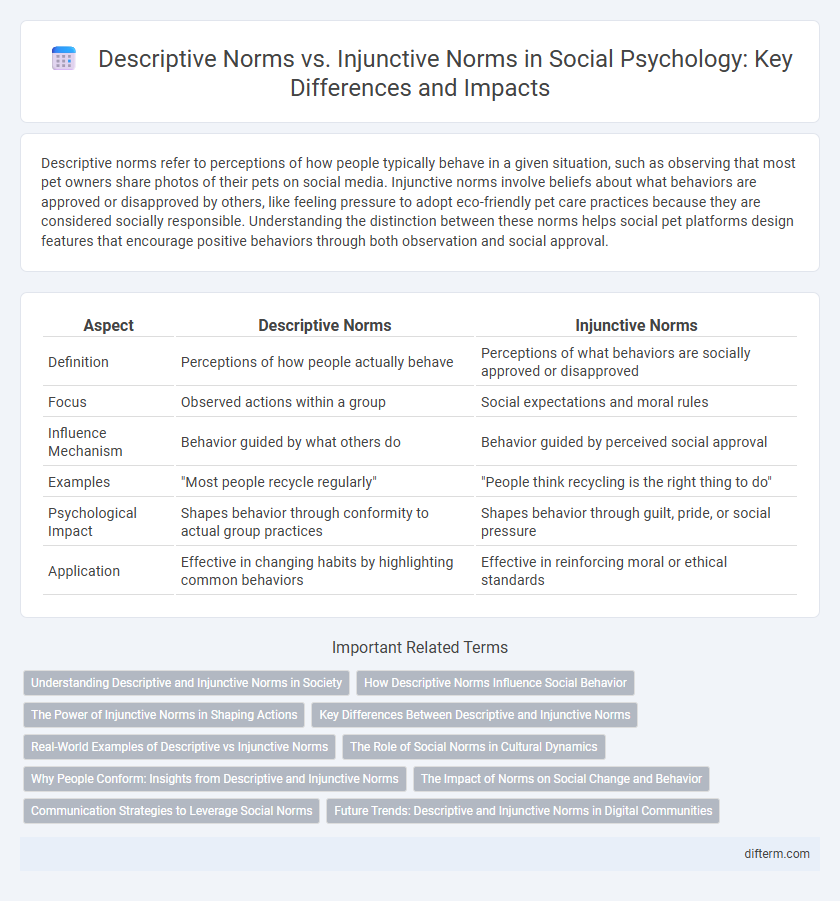Descriptive norms refer to perceptions of how people typically behave in a given situation, such as observing that most pet owners share photos of their pets on social media. Injunctive norms involve beliefs about what behaviors are approved or disapproved by others, like feeling pressure to adopt eco-friendly pet care practices because they are considered socially responsible. Understanding the distinction between these norms helps social pet platforms design features that encourage positive behaviors through both observation and social approval.
Table of Comparison
| Aspect | Descriptive Norms | Injunctive Norms |
|---|---|---|
| Definition | Perceptions of how people actually behave | Perceptions of what behaviors are socially approved or disapproved |
| Focus | Observed actions within a group | Social expectations and moral rules |
| Influence Mechanism | Behavior guided by what others do | Behavior guided by perceived social approval |
| Examples | "Most people recycle regularly" | "People think recycling is the right thing to do" |
| Psychological Impact | Shapes behavior through conformity to actual group practices | Shapes behavior through guilt, pride, or social pressure |
| Application | Effective in changing habits by highlighting common behaviors | Effective in reinforcing moral or ethical standards |
Understanding Descriptive and Injunctive Norms in Society
Descriptive norms refer to the behaviors that are commonly observed within a society, guiding individuals by indicating what is typical or normal. Injunctive norms involve perceptions of what behaviors are approved or disapproved by society, influencing actions through moral obligations or social sanctions. Understanding both norms is crucial for analyzing social influence, as descriptive norms motivate conformity through observation, while injunctive norms enforce behavior through social judgment.
How Descriptive Norms Influence Social Behavior
Descriptive norms, which reflect perceptions of what most people commonly do in a given situation, strongly influence social behavior by signaling acceptable actions within a group. These norms guide individuals by providing a behavioral reference point, often leading to conformity to group practices even without explicit approval or disapproval. Research shows that when people perceive a behavior as widespread, they are more likely to adopt it to fit in and avoid social sanctions.
The Power of Injunctive Norms in Shaping Actions
Injunctive norms, which communicate what behaviors are approved or disapproved by society, exert a powerful influence on individual actions by guiding moral conduct and fostering social approval. Unlike descriptive norms that describe what most people do, injunctive norms motivate behaviors through perceived social rewards or sanctions, effectively shaping compliance in communities. Research shows that emphasizing injunctive norms can significantly promote prosocial behavior, such as environmental conservation and public health adherence, by harnessing individuals' desire to conform to social expectations.
Key Differences Between Descriptive and Injunctive Norms
Descriptive norms refer to perceptions of how people actually behave in a given situation, guiding behavior based on observed actions, while injunctive norms involve perceptions of what behaviors are socially approved or disapproved, influencing behavior through social expectations and moral rules. Descriptive norms are informational and convey what is typical, whereas injunctive norms are prescriptive and convey what is right or wrong. Understanding these key differences helps in designing effective social influence interventions and behavior change strategies.
Real-World Examples of Descriptive vs Injunctive Norms
Descriptive norms are illustrated by the widespread practice of recycling in communities where most residents separate waste, signaling common behavior patterns. Injunctive norms appear in settings like workplaces enforcing a dress code to convey socially approved standards and expectations. These real-world examples reveal how descriptive norms guide actions based on others' behaviors, while injunctive norms influence behavior through perceived social approval or disapproval.
The Role of Social Norms in Cultural Dynamics
Descriptive norms, which reflect common behaviors within a group, shape daily social interactions by signaling what is typical and accepted in a culture. Injunctive norms communicate moral rules or approved behaviors, guiding individuals toward what is socially sanctioned or disapproved. Together, these social norms drive cultural dynamics by influencing conformity, social cohesion, and the evolution of shared values over time.
Why People Conform: Insights from Descriptive and Injunctive Norms
Descriptive norms influence behavior by indicating what most people typically do, creating a social benchmark that individuals follow to fit in or avoid standing out. Injunctive norms convey what is socially approved or disapproved, guiding behavior through perceived social rewards or punishments. Understanding the interplay between these norms reveals how conformity is driven by both factual evidence of common behavior and moral evaluations of appropriateness within social groups.
The Impact of Norms on Social Change and Behavior
Descriptive norms, which reflect what most people actually do, influence social behavior by providing a reference for acceptable actions, while injunctive norms convey societal approvals or disapprovals, shaping behavior through moral expectations. The impact of these norms on social change is profound, as shifts in perceived behaviors (descriptive) can alter collective actions, and changes in perceived societal values (injunctive) can redefine what is considered acceptable or taboo. Understanding the interplay between descriptive and injunctive norms is crucial for designing interventions that effectively promote sustainable social change and positive behavior modification.
Communication Strategies to Leverage Social Norms
Effective communication strategies to leverage social norms emphasize aligning messages with descriptive norms, which highlight what most people do, to encourage behavior adoption through social proof. Integrating injunctive norms, which convey what is socially approved or disapproved, reinforces motivation by appealing to individuals' desire for social acceptance and approval. Combining these approaches in campaigns enhances persuasive impact by simultaneously showcasing common behaviors and underscoring social expectations.
Future Trends: Descriptive and Injunctive Norms in Digital Communities
Descriptive norms in digital communities increasingly shape user behavior by highlighting common actions, driving engagement through perceived popularity and social proof. Injunctive norms emphasize community expectations and moral guidelines, promoting positive interactions and content moderation to maintain trust and safety. Future trends suggest a blending of these norms via advanced AI algorithms that tailor normative cues, fostering healthier online environments and enhancing user compliance with platform standards.
descriptive norms vs injunctive norms Infographic

 difterm.com
difterm.com